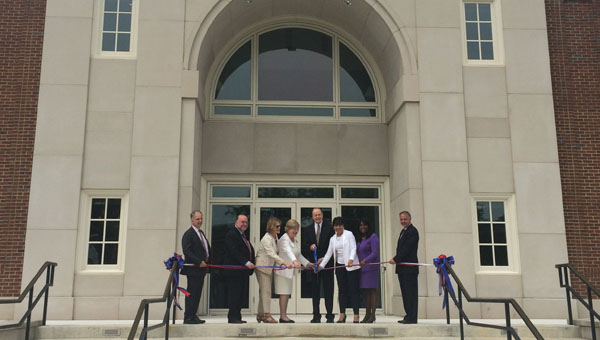The National Water Center, which first broke ground in 2012, will bring together several different agencies, including NOAA, United States Geological Survey and Federal Emergency Management Agency, to collaborate on water-related issues facing the country today.
“The importance of the National Water Center is to bring together NOAA’s capabilities in terms of predicting what is going to happen with water all over the country, along with other parts of the federal government,” said Penny Pritzker, U.S. Secretary of Commerce, who attended the dedication.
The goals of the center were physically included in the building’s design. The 65,000 square-foot building was designed to be a collaborative environment, earning the U.S. Green Building Council’s LEED gold certification, according to a press release from NOAA.
“It’s got really spectacular collaborative spaces everywhere, and of course located on the campus of this great university with the expertise of both the geosciences department and the engineering department in particular, we really will be able to use this as a national hub to drive innovation, to drive scientific advances and to improve the information services about flood and drought and water quality that are provided nationwide,” said Kathryn Sullivan, NOAA Administrator, who also attended the dedication.
Sullivan also said the center will eradicate the obstacles that arise when people from many different areas of a community attempt to solve a water problem. Community members, business owners and government officials often have to work together to address the concerns and needs of those affected by a water problem, she said.
“This center’s going to play a very strong role in helping erase all those seams,” Sullivan said.
Prior to the dedication ceremony, several high-ranking officials from the University of Alabama – all the way up the federal government – took a tour of the center. This tour group included Pritzker, Sullivan, U.S. Representative Terri Sewell and University of Alabama President Judy Bonner. The group was given a tour of the $23.55 million facility, including demonstrations from some of the staff.
The center includes a water resources forecasting operations center, an airborne snow and soil moisture observation analysis facility and several and development research facilities.
Joe Benson, Interim Provost and Vice President for Academic Affairs at The University of Alabama, said the center’s location on campus would help integrate the school into the water research community.
“I think it puts the University in the center of what is probably the premier water research facility in the world today, and it will allow our students and our faculty to interact with some of the preeminent scientists who are studying water in all facets,” he said.
Benson said those collaborations could begin as early as this summer.
“Our University is extremely proud to serve as the host campus with this exciting new building and all the collaboration that will take place between academic institutions, government agencies, the private sector, from all corners across America, that are involved in critical water research,” Bonner said during her speech at the dedication ceremony.
Several other officials made speeches after Bonner at the ceremony, including Richard Shelby, U.S. Senator from Alabama; Penny Pritzker, U.S. Secretary of Commerce; Terri Sewell, U.S. Representative from Alabama’s 7th District; Joe Nimmich, deputy director of FEMA; Bill Werkheiser, associate director of Water for the USGS; and Tom Bogdan, president of the University Corporation for Atmospheric Research. After the ceremony, Sullivan, Bonner, Shelby, Pritzker and Sewell cut the ribbon together on the steps of the National Water Center, followed by a reception inside.
The National Water Center on the University of Alabama campus is located at 205 Hackberry Lane.









